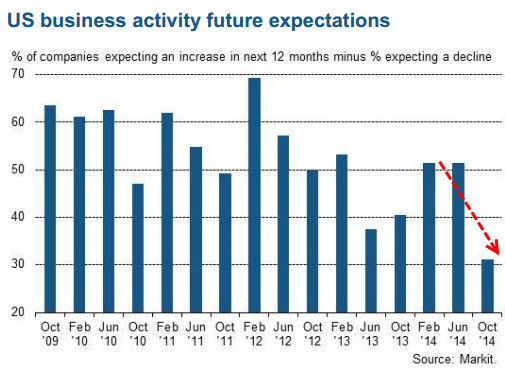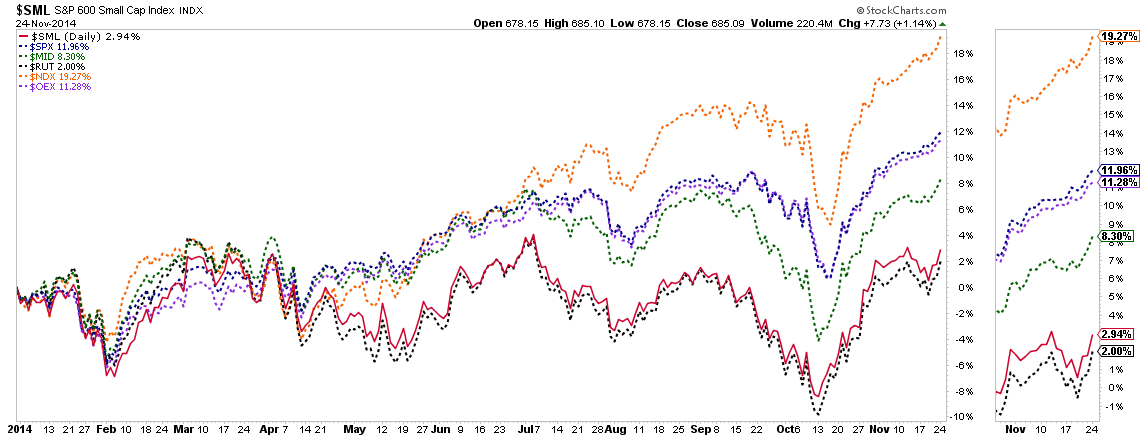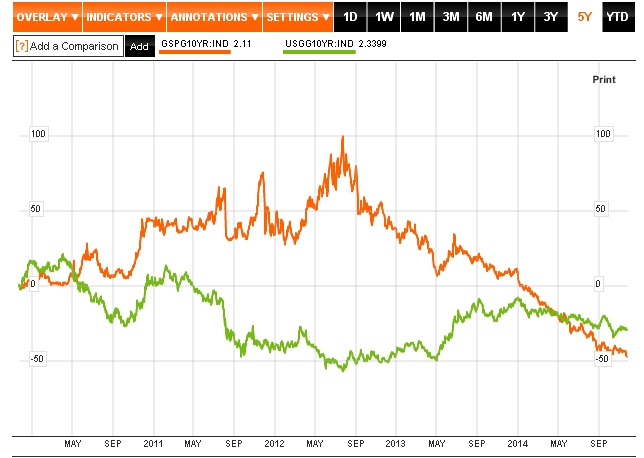by Lance Roberts of STA Wealth Management,
Data And Surveys Continue To Part Company
Last Friday, I discussed the growing gap between economic reports particularly when they measure the same basic areas of the overall economy. For example, how can the Markit Manufacturing PMI Index be negative for three months while the ISM PMI has surged higher during the same period. Both cannot be right.
Well, the same thing happened yesterday with the release of the Chicago Fed National Activity Index (CFNAI) which is arguably one of the most important economic indicators available. While the recent release of the Philidelphia Fed manufacturing survey surged to its highest level in years, the CFNAI fell to .14 from .29 last month.
(Note: The Chicago Fed National Activity Index (CFNAI) is a monthly index comprised of 85 subcomponents that provide a broad measure of economic activity nationwide.)
More importantly, while the Federal Reserve and ISM surveys have been showing strong increases in recent months; the production, income and consumption and housing components of the CFNAI have declined. The chart below shows the CFNAI index broken down into the 3-month average of supply (production, income, employment) and demand (consumption, housing, sales).
There are TWO very important things to take away from the chart above. First, supply and demand have had an extremely tight correlation prior to the financial crisis. However, since the last recession demand has underperformed supply to a significant extent which confirms the weak economic underpinnings for the majority of the country.
Secondly, while government related survey's are showing a vast improvement in economic activity, there has been little marginal improvement in the CFNAI. In fact, as shown in the chart below, the 3-month average has turned significantly lower in the second and third quarters of this year which suggests that real economic activity is slowing.
With the economic recovery now more than six years into recovery it has become a "footrace" to the finish line. With asset prices at elevated levels in anticipation of an economic revival, the failure of such a resurgence could lead to a significant disappointment for investors. With extremely cold weather threatening a large chunk of the population, there are risks to both corporate earnings expectations as well as to economic growth.
While there are indeed some very encouraging economic reports, it is important to remember that many are "sentiment surveys" that are subject to quick reversals.
Lastly, how is it the sentiment survey's are rising so strongly when CEO confidence is plunging. As Markit reports:
“This survey is a timely reminder that the U.S. economy has not been immune from weakening global business conditions, with euro area woes and heightened geopolitical risk weighing on firms’ business outlook and job hiring intentions for 2015."
“U.S. companies reported the lowest degree of confidence since the survey began in late 2009, reflecting domestic concerns and a subdued external demand environment."
Like I said in the beginning, most of the hard data suggests a much weaker economic environment than the current sentiment does. Both sets of data cannot be right.
The Charge Of The Large Caps
One of the early warning signs of late stage bull market cycles is a narrowing of leadership in the markets. As the bull ages money tends to chase fewer and fewer stock into the peak. The chart below shows the S&P 600 small-cap, Russell 2000, S&P 400 mid-cap, S&P 100, Nasdaq 100 and S&P 500 large-cap indicies.
As you can see, since the beginning of the year money has continued to chase fewer and fewer stocks with the large cap technology-heavy Nasdaq 100 leading the charge.
Of course, the last time that the Nasdaq 100 took a rather stellar lead in performance over the vast majority of other stocks was heading into 2000. While I am certainly not suggesting that the recent narrowing of performance is a sign that a market crash is imminent, it is important to understand that a narrowing of leadership has historically been attributed to an "aging bull market."
As Keith Jurow recently penned:
"Advisors must consider the possibility that what is assumed may not be true. This means challenging common perceptions. While not an easy task, it is absolutely essential for any investment advisor whose clients have large asset portfolios at risk."
Are We Taking Liquidity For Granted
Tracy Alloway recently penned:
"To be clear, the lack of liquidity just exacerbates market moves. The underlying problem is that complacent investors have been in the same (long) positions for the past five years, selling volatility and levering up to boost returns."
This is an important point. Investors have come to take a flood of liquidity by Central Banks as a given. However, what investors have come to take as a "given" may, in fact, be a mirage. The Federal Reserve has recently stopped its most recent innovation of direct liquidity injections. Furthermore, the BoE's Mark Carney recently gave a speech suggesting:
"It is particularly notable how the search for yield has compressed liquidity premia across markets. This is unlikely to be sustainable over the medium term because it exists against a backdrop of much-reduced market-making activity. Fundamentally, liquidity has become more scarce in secondary fixed income markets. It just appears that it hasn’t."
However, as investors continue to chase yield in a low interest rate environment, the push has primarily been focused in the riskiest of bond issuances. For example, Spanish bonds recently traded with a yield of below 2%. Since interest rates are a function of the "risk" that is undertaken by the lender, is this a suggestion that Spain is a more credit worthy borrower than the U.S. Hardly. It is, however, a sign that investors believe that whatever happens a central bank will gladly bail them out.
Carney comments suggests that the belief of infinite liquidity may be flawed.
"New prudential requirements have reduced incentives for banks to warehouse risk positions. Dealer inventories in fixed income have declined by 70% since the pre-crisis period, while the stock of fixed income assets outstanding has doubled. And the Value-at-Risk in banks’ trading books has retreated to 2002 levels.
The time to liquidate a given position is now seven times as long as in 2008, reflecting much smaller trade sizes in fixed income markets. In part the current liquidity illusion is a product of the risk asymmetries implied by the zero lower bound on interest rates, excess reserves in the system, and perceived central bank reaction functions. However, interest rates in advanced economies won’t remain this low forever. Once the process of normalization begins, or perhaps if market perceptions shift, and it is expected to begin, a re-pricing can be expected.
The orderliness of that transition is an open question."
This is a hugely important statement. While Central Banks globally have gone "all in" on keeping the current environment stable in the face of global deflationary pressures, they cannot control the "psychology" of the market if, or when, something breaks.
The rise of illiquidity in the fixed income markets is a byproduct of the bond buying schemes run by Central Banks globally. The problem comes when someone, somewhere, decides to sell.




















